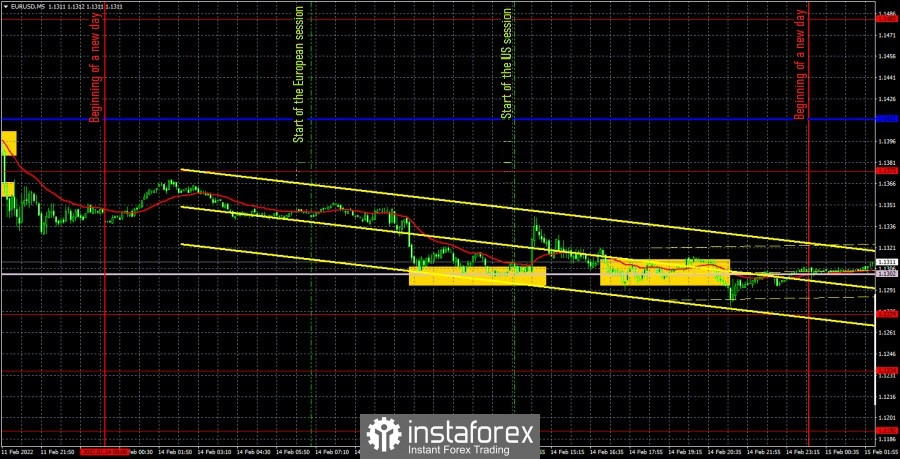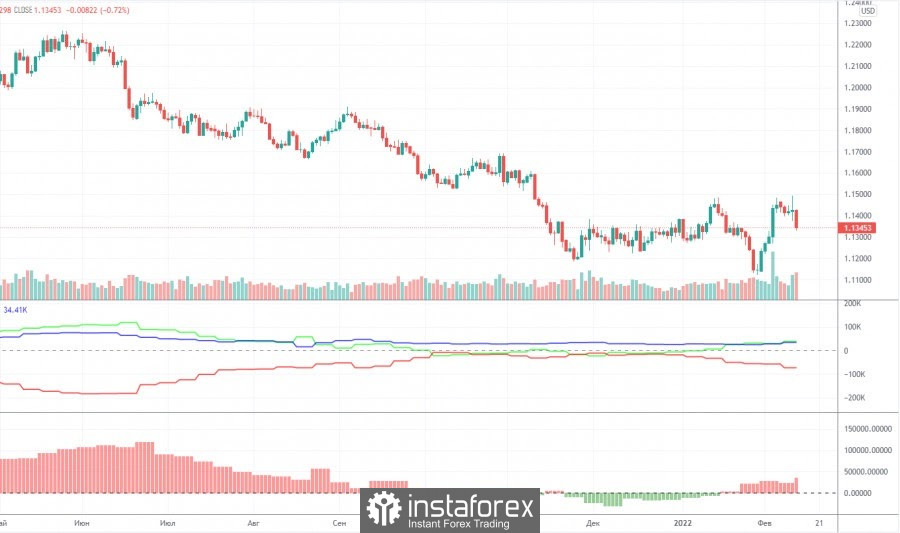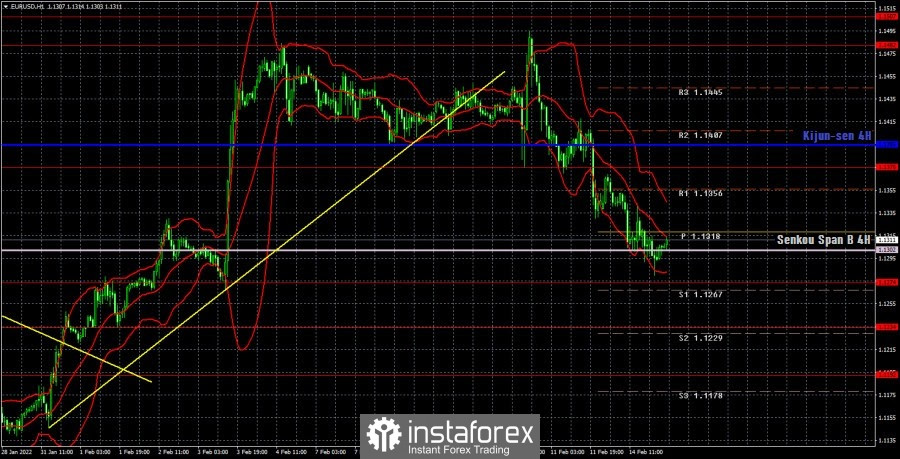EUR/USD 5M

The EUR/USD pair as a whole continued its downward movement on Monday. However, the very nature of the movement was quite complex. A clear plus is the fact that the price has been striving for the Senkou Span B line all day and has reached it twice. However, it did so in some form of jolt, and at the beginning of the trading day, not a single trading signal was formed to work out the fall of the pair. There were two "jolts". The first was in the European session, when the price simply collapsed by 50 points in an hour, and the other at the beginning of the US session, when it increased by 40 points in ten minutes. However, in the end, the pair still returned to the Senkou Span B line, and it is quite difficult to say what provoked such sharp movements, since no important macroeconomic statistics were planned for Monday. But in the morning it became known that an emergency meeting of the Federal Reserve would begin in the evening. But since it will obviously not last half an hour, it probably doesn't make sense to expect quick results.
Now as for trading signals. There were only two of them during the day. And both are "bad". For the first time, the price bounced off the Senkou Span B line several times, but each time only by 10-15 points, so we combined these signals into one. At the most, the pair went up 40 points. This is what traders could earn on this signal. For the second time, the price reached the Senkou Span B line in the late afternoon, so it was not necessary to open positions on this signal. In the end, it wasn't so bad, it could have been much worse. However, it should be noted that the markets may now be in a nervous state due to "geopolitics".
COT report

The new Commitment of Traders (COT) report, which was released on Friday, did not show any major changes, and its data does not reflect what is happening in the foreign exchange market at all. In short, professional players continued to increase long positions during the reporting week, as well as get rid of short positions. In total, the net position of the non-commercial group increased by 11,000. So now we have a picture in which major players have been buying the euro currency for several consecutive weeks, and their mood is clearly bullish. The new COT report shows the behavior of traders a week earlier (it comes out with a 3-day delay). And last week, the euro was growing steadily. However, look at the chart above: is the current technical picture similar to the beginning of an upward trend? After all, even last week the price updated its annual lows! Thus, formally, it can be concluded that the major players are already looking towards long positions on the euro currency, but in practice this mood is so unstable that at any moment it can result in a new fall of the euro/dollar pair. The main factor that should be taken into account now is the lack of growth factors in the euro. And if we add to this the tense geopolitical situation that developed at the beginning of the new year, then it is the dollar that has additional growth factors. And there were plenty of them even without geopolitics. Thus, as before, there is a high probability of dollar growth.
We recommend to familiarize yourself with:
Overview of the EUR/USD pair. February 15. "Geopolitics" and an emergency meeting of the Fed. How will it end?
Overview of the GBP/USD pair. February 15. Boris Johnson takes an active part in resolving the US–Ukraine–Russia conflict.
Forecast and trading signals for GBP/USD on February 15. Detailed analysis of the movement of the pair and trading transactions.
EUR/USD 1H

The euro/dollar pair fell to the Senkou Span B line on the hourly timeframe, so now it should decide: either a further fall, or a rebound and a round of upward movement. Given the fundamental background, we believe that the decline will continue, and the Senkou Span B line will be overcome. On Tuesday, we allocate the following levels for trading – 1.1192, 1.1234, 1.1274, 1/1375, 1.1482, 1.1507, as well as the Senkou Span B (1.1302) and Kijun-sen (1.1395) lines. There are also support and resistance levels, but no signals will be formed near them. The lines of the Ichimoku indicator may change their position during the day, which should be taken into account when searching for trading signals. Signals can be "bounces" and "breakthrough" levels - extremes and lines. Do not forget about placing a Stop Loss order at breakeven if the price went in the right direction of 15 points. This will protect you against possible losses if the signal turns out to be false. The GDP for the fourth quarter will be published in the European Union on February 15, but since this is the second estimate of the indicator, it is unlikely to differ in any way from the first. And the traders completely ignored the first assessment. The results of the Fed's emergency meeting is much more important, which will probably be announced today. They can provoke a new strengthening of the US currency.
Explanations for the chart:
Support and Resistance Levels are the levels that serve as targets when buying or selling the pair. You can place Take Profit near these levels.
Kijun-sen and Senkou Span B lines are lines of the Ichimoku indicator transferred to the hourly timeframe from the 4-hour one.
Support and resistance areas are areas from which the price has repeatedly rebounded off.
Yellow lines are trend lines, trend channels and any other technical patterns.
Indicator 1 on the COT charts is the size of the net position of each category of traders.
Indicator 2 on the COT charts is the size of the net position for the non-commercial group.





















